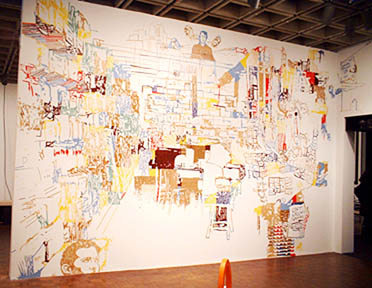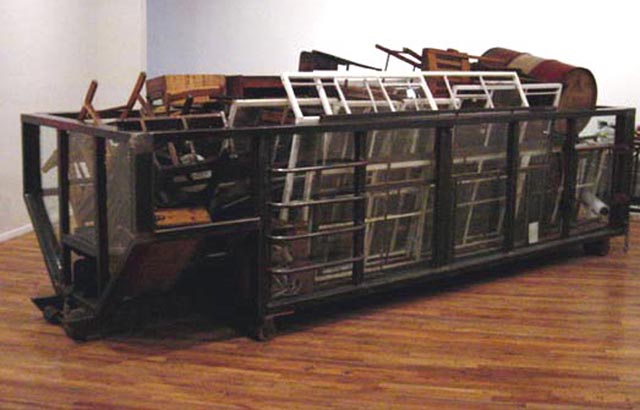Art Review: The Whitney Looks to the Interior
Michael Fallon is back from New York, where he visited Minnesota art at the Whitney Biennial. Here's his thoughts on how the Minnesota work reads in a national context.



There’s a lotta good art coming out of Minnesota these days if you know where to look. Consider what New York Times’ art critic Michael Kimmelman wrote about a Minnesota artist in his review of the Whitney Biennial (which runs through May 30). “Alec Soth, photographer,” he proclaimed, “[is a] good discovery.” And of course, as was announced on mnartists.org a few days ago, there are actually three more Minnesota artists in this year’s Biennial with Minnesota connections: installationist Santiago Cucullu, sculptor Rob Fischer, and documentary filmmaker Bill Siegel.
Having four artists with Minnesota connections in this national showcase for art is a bit unusual. Just for comparison, the 2002 Biennial featured no Minnesota artists of any sort, and the 2000 featured only photographer Paul Shambroom. Douglas Fogle, who advised the Biennial’s curatorial staff, may have insights about why it happened this year (he is slated to write about his experiences for mnartists.org in May). I suspect, however, that the glut of Minnesota connections in the current Biennial has to do with the way Minnesota artists match up with the concerns put forward as the show’s theses.
According to the Biennial’s press materials, this year’s curatorial staff–Chrissie Iles, Shamim Momin, and Debra Singer– focused on specific aspects of the national art scene. To quote:
Several generations of artists are featured in the [2004] exhibition, in a conversation that reflects a number of overlapping trends:
So instead of harping on new-media, on the experimental, on hip conceptualism, and on performance (which supposedly typified the Biennial’s last two incarnations), the curators wanted idiosyncratic and obsessive artistic visions and they wanted more traditional media. The press kit also described the curator’s goal of creating out of these theses an “intergenerational conversation,” by linking established artists who emerged during the late 1960s, 1970s, and 1980s–David Hockney, Richard Pettibone, Paul McCarthy, Richard Prince, Yayoi Kusama, etc.—with younger, emerging artists who grew up in this era and were perhaps inspired by these old-timers’ visions.
This interest in younger, emerging artists favors Minnesota, as by definition our art scene is an emerging artists market. That is, because there is no art-buying market to speak of here, Minnesota artists must look to elsewhere once their careers begin to blossom. But I think there’s another reason so many Minnesotans fit into this year’s Biennial. While most critical assessments of the show have focused on how the curators have included much traditional media–drawing, painting, standard forms of photography, scratchy analog film projections—the curators’ interest in this particular time-locus (late ‘60s through to 1980s) was the actual driving force behind the exhibition’s look and feel. By placing the aesthetic vision of the show in a particular era, the curators, knowingly or unknowingly, have reproduced a particular visual landscape—one that anyone of my generation will be familiar with. It’s a cultural melange of the tacky-pop stuff this country produced between the last innocent days just before Altamont and Kent State and the emergence of the sophisticated market-segmentation and resulting cultural fragmentation in the late 1980s.
This is a vision of the world in which the chasm between high and low culture is not terribly wide, in which the middlebrow culture that bubbled up in the vast middle swath of the country was widely accepted by all stripes; it is a less-than-urbane, more mittelamericanisch vision. The young artists in this show are not only reliant on appropriated pop culture–duly run through the blender, mash-potatoed, consumed, and regurgitated–but they could not exist without this particular era’s tendency to create semi-universally witnessed cultural moments whose significance depends solely on this witnessing (and not on any event’s inherent importance ).
In the show this year, for example, there is an artist whose installation references the disco era (Christian Holstad), an artist who makes a Playboy Mansion-style mirrored parlor (Virgil Marti), an artist who hacks into vintage video games to make installations (Cory Arcangel), and artists who reference glam rock, funk music, psychedelia (endless psychedelia, actually), and comic books. Matthew Ronay’s 70s Funk Concert Model, for instance, looks like Robert Gober meets Playskool. There are plastic body parts, fake fruit and pancake stacks and other food items, a fox’s head—all arranged in random, Goberesque conglomerations. And it is absolutely precious that this all is supposed to somehow reference 70s funk music acts such as Earth, Wind & Fire and Curtis Mayfield & the Impressions, and that all of this is supposed to mean something.
Precious too is Virgil Marti’s 1970s lounge installation; it is a room covered with mylar, silkscreen-printed with patterns of flowers and other items, and hung with a treacly chandelier made from colored resin. Banks Violette, meanwhile, draws from the glam-rock era, stealing imagery from sources such as Slayer and Kurt Cobain and presenting a stage in the center of the room with concretion of drum hardware and melted polystyrene, polyurethane, and tinted epoxy, like the aftermath of an apocalyptic concert. Isaac Julien, meanwhile, made a documentary film on the Blaxploitation films of the 1970s; Richard Prince made sculpture derived from the hoods of 1970s-era muscle cars; Zak Smith drew inspiration from Japanese manga and other comic books, and from the pages of Thomas Pynchon’s 1973 novel Gravity’s Rainbow; and so on, and so forth.
Minnesota artists fit into this bunch, I think, because their concerns tend toward this same realm–it draws from the middle American’s middle brow, and seeks meaning not in solipsistic and idiosyncratic visual experimentation but cultural motifs common to the rest of the country. Minnesota artists are generally hyperaware of what’s out there, artistically speaking, and generally create work that addresses the bigger cultural picture. (This is true even though you’d generally think the opposite would occur, considering the place’s remoteness and the whole winter isolation thing.)
Alec Soth’s work in particular travels a well-worn swath down the center of the country—following themes that writers like Twain examined. His series of photos, taken on trips down the Mississippi River and called (in a Twain quote) “Sleeping by the Mississippi,” basically asks the question: What is Middle America? The people and places Soth finds to depict in his photos are the universal “us.” They are people who visit polka bars with red vinyl booths, people with paint peeling in their bedrooms, people with brown-red Barcaloungers who secretly read Hustler by the fireplace. His roving eye finds traveling preachers, hookers, aging Southern matrons, barflies, and the like on his travels through the heartland, and he makes sad poetry out of the way these people reflect ourselves back at us.
While Santiago Cucullu’s subject matter isn’t particularly middle-American (it draws from sources such as early 20th-century Argentinian politics and Marxist philosophy, obscure to most middle-American audiences), his materials are sheer 1973. He makes installational murals from faux wood-grained and cheap vinyl contact papers–the material that lined the cabinets of a million tract homes in 1975. Bill Siegel’s documentary film on the Weather Underground, meanwhile, traces the evolution of the group from the late 1960s up to the present day, and most of the crucial events discussed in the film (bombings, mostly, and the flight underground by Weathermen to evade the FBI) occurred in the 1970. And Rob Fischer’s large sculptures draw inspiration from the aging cast-off structures found in millions of remote places across the country: falling-down corrugated-iron shacks, boathouses and houseboats, and any structure with the patina of benevolent neglect.
In the end, the time was ripe for these Minnesota-connected artists to be launched on the national scene by a midward-looking Whitney Biennial. Alec Soth, in particular, is fast turning into a national and international figure. And this proves what we all here in flyover land have long known: Good art does come from the middle of the country.